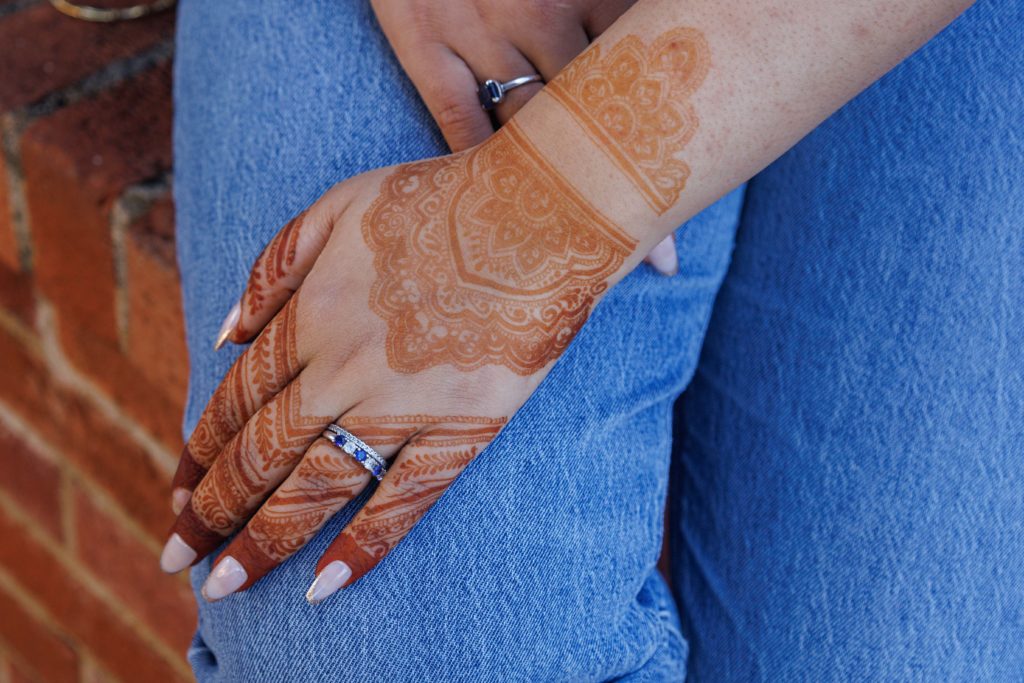This post was updated Feb. 13 at 11:22 a.m.
Aatmi Mehta is using henna as an art form to convey tradition and self-expression.
The second-year public health student runs a small henna business. Although she finds joy in creating art for others, Mehta said henna will always be a personalized craft for her. Using it as a way to de-stress and experiment creatively, she said she is constantly coming up with new ways to implement her designs.
“The freedom of being able to make my own henna and do it myself on my own – it’s a very freeing art,” Mehta said. “I find it pretty easy to use it as stress relief or just a creative outlet.”

[Related: Despite a STEM background, alumnus Sally Qiu inks own path as tattoo artist]
Mehta, who was born in the Indian state of Gujarat, said she discovered her passion for henna because it is a significant part of Indian culture. Henna art was always a prominent part of her life, Mehta said. Growing up in a creative household, this art form served as another outlet to experiment with design, she added.
Mehta’s longtime friend and neighbor Priyanka Iragavarapu, a fourth-year economics and statistics and data science student, said Mehta has always been creative. Mehta and her mom were constantly looking for ways to make art, from earrings to traditional Rangoli designs, Iragavarapu said.
“She always had a different form of art that she was attached to at any given time,” Iragavarapu said. “Even though she has gone through different phases of choosing one art form for another, henna and mehndi has always stuck with her.”
Mehta said her business grew when she discovered how to whip her own henna from scratch, learning from professionals in a bridal course she took in India a few years ago. In this course, she experienced being part of the bridal team for a wedding, which soon became one of her favorite events to design for, Mehta said.
In India, she learned how to create her own cones, Mehta said, allowing her to curate intricate designs. A distinct element of her business is that clients can buy cones directly from her, Mehta said. She uses natural oils and avoids chemicals typically found in store-bought cones, she added.
“Making my own cones means I can control the thickness and consistency of the henna, so that makes it much more customizable for my skills,” Mehta said.
Reflecting upon the challenges that come from being a student henna artist, Mehta said henna is a very meticulous art. She said she needs a 48-hour notice to whip the henna, learn what design her client is drawn to and then sketch the designs on her iPad. In total, a typical session lasts about 30 minutes, Mehta added.
Regarding her clients, Mehta said she transitioned from doing henna on herself as a way to relax to sharing her art with other people. When individualizing her art, Mehta said her designs vary depending on the client. However, flowers and fine-line patterns will always be her signature style, she said. The cost of a design depends on the intricacy and size, Mehta said. After the client chooses their design, the process of curating these designs is a very intimate experience, she added.
“I love solo events because it’s super fun and intimate,” Mehta said. “You get to know your client a lot. You’re just sitting there chatting, and it’s a really good time.”
[Related: Student Christina Williams tells client stories through ink]
Nemi Desai, a second-year computer science student and Mehta’s roommate, said Mehta does a good job at making her art meaningful to the client. Taking her own experience into account, Desai said Mehta’s mind is a lot more creative than hers. She lets her have free rein over her designs, and it always turns out beautifully, Desai said.
“Being in the presence of someone who is super excited about it (henna) and really interested in trying out new designs gets me to appreciate art a lot more,” Desai said. “There’s a lot more variety in art and ways to perform art and view it in a way that has different meanings and different purposes”
Although on a STEM track, Mehta said she will continue engaging in henna art in the future. Mehta said she continues to make time for henna art, even when taking difficult classes at UCLA. Viewing henna art as a motor skill, Mehta said developing this skill has taken time, and she plans on expanding it further.
“I just love making them (clients) happy and getting to share my art with them,” Mehta said. “If someone asked me to do henna, I would be so, so happy to do it.”
This post was originally published on this site be sure to check out more of their content







